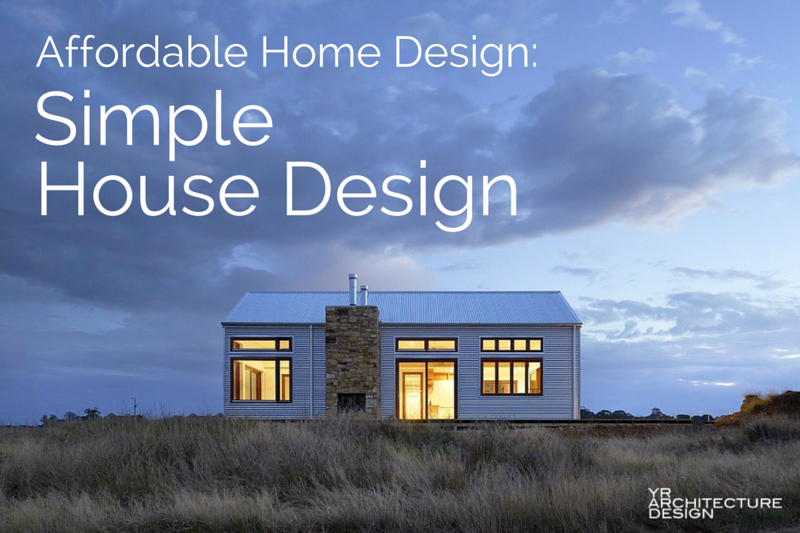If you’re in the market to create a new custom home, you’ve probably shopped around on Houzz or Pinterest or in shiny design magazines for the perfect ideas for your home.
What you probably don’t realize is that those neatly packaged perfect homes are the result of a lot of time, effort, and money. Unfortunately, many homes in magazines aren’t affordable to most people.
But, don’t let that discourage you from building your dream home. To help you design a more affordable home, we’ve put together this Affordable Home Design Series.
In previous posts, we’ve discussed good site planning principles and efficient floor plans. This post is going to piggy-back onto our previous post on efficient floor plans and take a closer look at ways to create a simple house design. Simple, straightforward floor plans, footprints, and overall configuration of spaces can have significant cost savings both during construction and over the life of your home.
Let’s take a look.
Simple, Straightforward Design
When you’re designing your home, consider the complexity of your design. The simpler the floor plan and more straightforward the details, the easier, the cheaper, and the faster it is to build.
Simplify Your Home’s Footprint and Layout
Throughout modern history, houses, for the most part, have been rectilinear in nature. Think of log cabins – simple, rectangular boxes with a gable roof. It’s easier to build a house that has a simple form. Complex building footprints with a lot of ins and outs, angled walls, curved walls or complicated roof lines are obviously more difficult to build and take more time.
They are also more expensive.
It takes more time to stake out the footprint for complex homes, which means more labor costs. A floor plan with a lot of ins and outs also means more exterior walls.
More linear feet of walls: more material + more time = higher labor and material costs AND a longer construction schedule
Also, remember that level changes are more expensive, too. There are many reasons why having small level changes might be nice, most notably, to follow more closely with the topography and enable more opportunities to walk out to the exterior. But just remember these small level changes from room to room cost money. If you’re interested in finding ways to reduce costs, consider sticking to consistent floor levels instead of having small level changes.
If you have a lot of walls in your design, try lining them up. Is it necessary to have walls that are a few inches off of alignment or are angled a few degrees? Maybe. Just remember that it might take more time (and more labor hours) to lay out the walls.
If you have a multi-story home design, consider grouping systems together to minimize duct and piping runs and create a more energy efficient design. Consider a centrally located mechanical system or stacking bathrooms on top of each other to reduce runs and make them more efficient. Anything you can do to create more compact systems will almost always result in a more cost-effective design.
Reduce Square Footage Where Possible
As mentioned in our previous post, a smaller, floor plan is more cost-effective and more efficient. We’ve discussed many of these ideas before when we discussed strategies for designing a smaller home and how to design more efficient floor plans.
If your floor plan has a bunch of smaller rooms, consider removing some walls. Or consider combining spaces and making an open floor plan and eliminating redundant spaces. For examples on how to create a floor plan with only the necessary spaces, check our these minimalist floor plans for inspiration.
All of these strategies help make your home design more cost-effective. Try a few of them and see if you can squeeze out a few square feet from your total floor plan.
Remember, more walls = more material and labor.
And more square footage = higher energy costs and utility bills.
A simple house design that is compact, efficient, and straightforward can considerably reduce the cost and time it takes to build your home – making it that much more affordable to you.
If you’re considering ways to build a more cost-effective home, consider a modern, minimalist home. Modern home design lends itself to a more cost-effective design. Modern homes typically have open floor plans, simple volumes of spaces, and minimalist detailing – many of the topics have been covered in today’s post.
Follow along to our next article in our Affordable Home Design Series or check out all of our Affordable Home Design resources here.
Cost-Effective Materials & Simple Details >




![5 [BIG] Design Moves](https://i0.wp.com/yr-architecture.com/wp-content/uploads/5-BIG-Design-Moves.jpg?fit=800%2C533&ssl=1)









